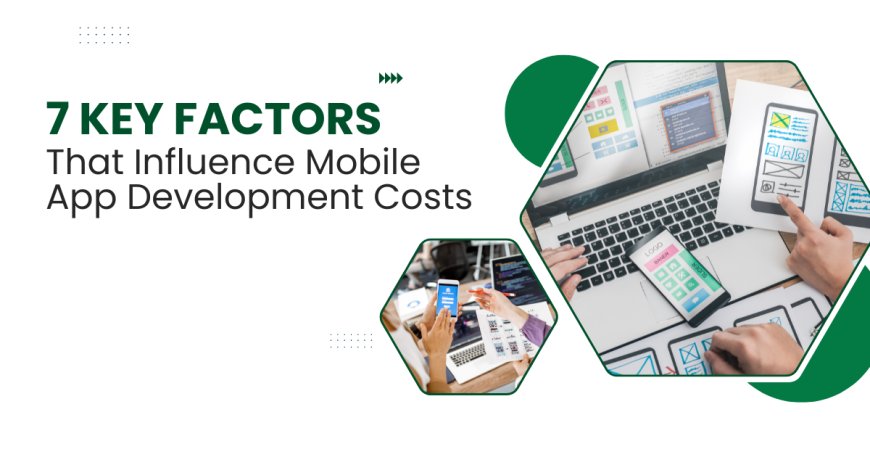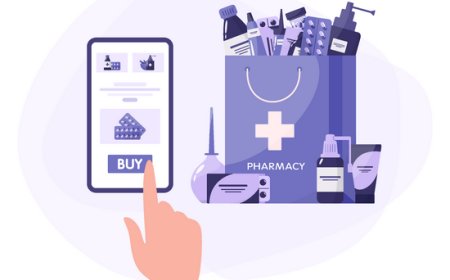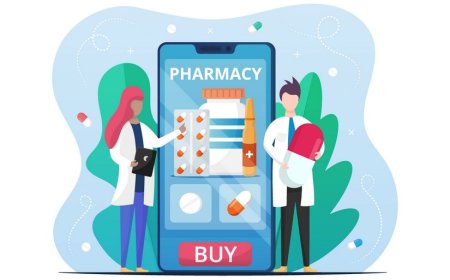7 Key Factors That Influence Mobile App Development Costs

In today's fast-paced digital world, mobile applications have become crucial for businesses to engage with customers, improve operations, and expand their reach. According to a report by Statista, mobile app revenue worldwide is projected to reach $407.31 billion by 2026. As demand for mobile apps grows, so do the challenges in building them, including the associated costs. Understanding what factors influence mobile app development costs is essential for businesses to make informed decisions, whether they are partnering with an Android Mobile App Development Company or leveraging Android Application Development Services.
In this article, we’ll explore seven key factors that significantly impact the cost of developing a mobile app. From the complexity of the app to the choice of development platform, each of these elements can either increase or decrease the overall cost.
1. App Complexity and Features
Simple vs. Complex Apps
One of the most significant factors influencing mobile app development costs is the complexity of the app. A simple app with a limited set of features will cost far less than a sophisticated app that incorporates multiple functions, integrations, or high-end features.
Simple App Example:
-
Basic functionalities like login, user profiles, and product display.
-
Development time: Around 2–3 months.
-
Cost Estimate: $10,000 to $20,000.
Complex App Example:
-
Advanced functionalities such as real-time chat, geolocation, third-party integrations, and in-app purchases.
-
Development time: 6+ months.
-
Cost Estimate: $50,000 to $150,000+.
The more complex your app, the more it will cost to develop. Features like payment gateway integration, real-time functionalities (like chat or video calling), or AI-driven services will require additional expertise, which can drive up costs.
Table 1: App Features and Development Complexity
|
Feature |
Complexity Level |
Estimated Cost Range |
|
Basic Login & Profile Management |
Low |
$10,000 - $20,000 |
|
E-Commerce Functionality (Cart, Payment) |
Medium |
$20,000 - $50,000 |
|
Real-Time Chat, Video Calling |
High |
$50,000 - $100,000 |
|
AI-Based Personalization & Analytics |
Very High |
$100,000+ |
2. Platform Selection
Android vs. iOS Development
The platform you choose for app development plays a critical role in determining the cost. Developing for Android involves considerations like multiple screen sizes, device types, and OS versions, all of which can increase development time.
-
Android Development: Developing an app for Android usually takes longer due to the need to test across a wide range of devices and OS versions. The cost may be higher if your app needs to cater to various Android devices, from smartphones to tablets.
-
iOS Development: iOS development is typically more straightforward, as the number of devices and OS versions is smaller compared to Android. As a result, development time can be shorter, and costs can be somewhat lower.
Hybrid or Cross-Platform Development:
Another option is using cross-platform tools like Flutter or React Native to build apps for both Android and iOS simultaneously. While this can reduce the cost compared to developing two separate native apps, it can still be more expensive than developing a single-platform app due to the complexity of building a cross-platform solution.
Table 2: Development Costs by Platform
|
Platform |
Estimated Development Time |
Estimated Cost Range |
|
Android |
3–6 months |
$20,000 - $80,000 |
|
iOS |
2–4 months |
$15,000 - $50,000 |
|
Cross-Platform (Flutter/React Native) |
4–8 months |
$30,000 - $100,000 |
3. Design and User Experience (UX/UI)
The design of an app is one of the first things that users notice. A sleek, easy-to-navigate app with an intuitive UX/UI design can significantly enhance user retention. However, high-quality design also comes at a price.
-
Basic Design: Basic, template-based designs with limited customization will cost less.
-
Custom Design: A fully customized design that matches your brand’s identity and provides a unique user experience will be more expensive.
Factors Influencing Design Costs:
-
Custom illustrations and animations.
-
Multiple design iterations and user testing.
-
The complexity of UI elements (buttons, forms, icons).
The more time and effort you invest in UX/UI, the more expensive it becomes. However, it’s crucial to remember that a well-designed app can lead to higher user engagement, which may justify the higher initial cost.
Table 3: Design Costs
|
Design Type |
Complexity Level |
Estimated Cost Range |
|
Template-Based Design |
Low |
$5,000 - $10,000 |
|
Custom Design with Animations |
Medium |
$10,000 - $30,000 |
|
Fully Customized Design |
High |
$30,000+ |
4. App Maintenance and Updates
App development does not end when the app is launched. Ongoing maintenance is required to keep the app functional, secure, and updated with the latest features. Maintenance costs typically include:
-
Bug fixes and updates.
-
Compatibility checks with new OS versions.
-
Server and database management.
-
Regular performance improvements.
On average, app maintenance can cost between 15% to 20% of the initial development cost per year. If you opt for an Android Mobile App Development Company, you may enter into a long-term partnership for regular updates and support.
Table 4: Maintenance Costs
|
Development Cost |
Annual Maintenance Estimate |
|
$10,000 |
$1,500 - $2,000 |
|
$50,000 |
$7,500 - $10,000 |
|
$100,000+ |
$15,000 - $20,000 |
5. Development Team and Expertise
The expertise of the development team directly influences the cost. A highly skilled and experienced team may charge more, but they will be able to deliver a better-quality app, faster. Key roles in an app development team include:
-
Project Manager: Ensures timely delivery and cost management.
-
Developers: Handle the coding, testing, and troubleshooting.
-
Designers: Create UI/UX elements.
-
Quality Assurance (QA) Engineers: Ensure the app works seamlessly.
Hiring an Android Application Development Services provider with a strong portfolio and a skilled team can lead to a better app with fewer delays and errors, potentially saving costs in the long run.
Table 5: Team Cost Breakdown
|
Role |
Average Hourly Rate |
Cost Estimate (for 3-month project) |
|
Project Manager |
$60 - $150 |
$15,000 - $30,000 |
|
Android Developer |
$40 - $100 |
$10,000 - $30,000 |
|
UX/UI Designer |
$50 - $120 |
$8,000 - $25,000 |
|
QA Engineer |
$30 - $70 |
$7,000 - $20,000 |
6. Third-Party Integrations
Integrating third-party services or APIs into your app can also increase development costs. Popular third-party services might include:
-
Payment gateways (e.g., PayPal, Stripe)
-
Location-based services (e.g., Google Maps API)
-
Cloud storage services (e.g., AWS, Firebase)
-
Social media logins (e.g., Facebook, Google login)
Each integration requires development time, testing, and possible license fees for the use of these third-party services, all of which contribute to the overall cost.
7. App Security
Security is a critical aspect of mobile app development, especially for apps dealing with sensitive data such as personal information, payment details, or business data. The implementation of robust security features, such as encryption, secure data storage, and user authentication mechanisms (e.g., biometrics), will add to the development costs.
While basic security measures are included in the development process, more advanced security features often require specialized expertise and can significantly raise costs.
Table 6: Security Features and Costs
|
Security Feature |
Complexity Level |
Estimated Cost Range |
|
Basic Encryption & Authentication |
Low |
$5,000 - $15,000 |
|
Multi-Factor Authentication |
Medium |
$10,000 - $30,000 |
|
Advanced Security (Biometrics, Encryption) |
High |
$20,000 - $50,000 |
Conclusion
Understanding the factors that impact mobile app development costs can help you make better decisions when planning and budgeting for your app project. Whether you are working with an Android Mobile App Development Company or seeking Android Application Development Services, consider the complexity, platform, design, and maintenance needs of your app, as well as the skills of the development team, to better estimate costs.
While it may be tempting to cut corners, investing in high-quality development, robust security, and user-centric design can lead to greater success, enhanced user satisfaction, and better ROI in the long run.
What's Your Reaction?






















